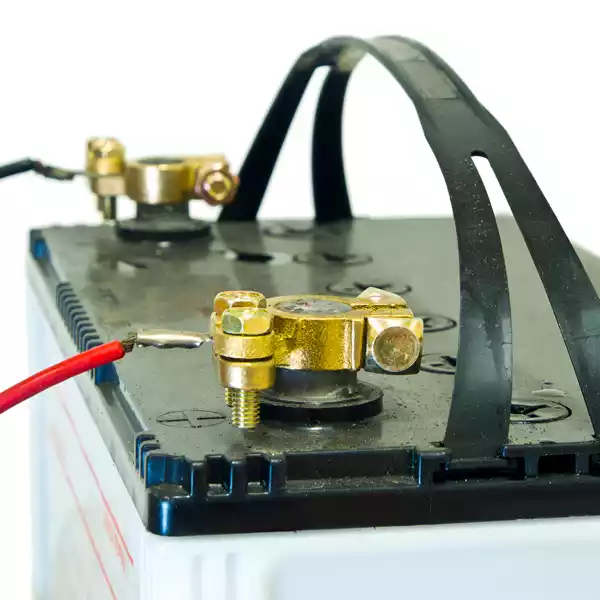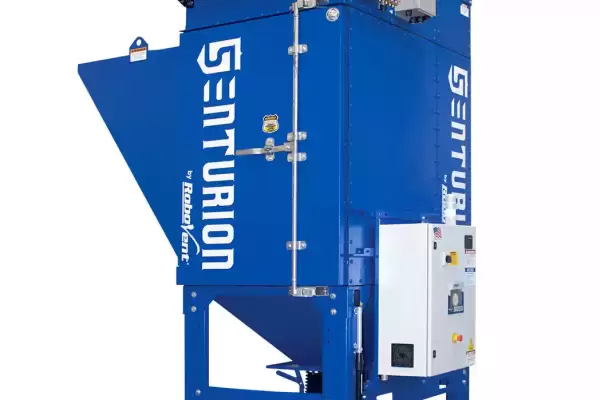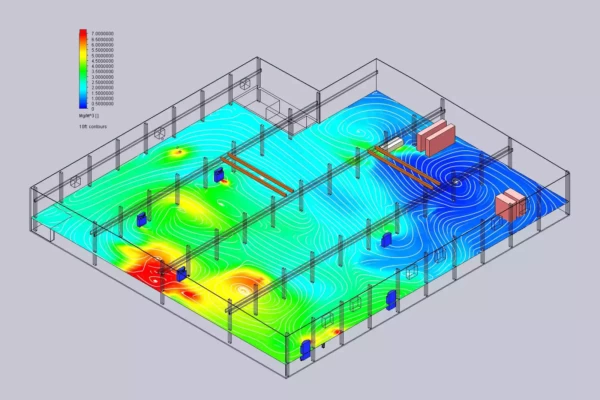DUST TYPES IN LEAD-ACID BATTERY PRODUCTION
Lead-acid battery manufacturing produces toxic dust and fumes that must be controlled to protect workers and keep facilities safe. Most of this dust is generated during electrode production and cell assembly processes, such as lead paste mixing, pasting, curing, and grid casting. Lead and lead alloy dust created during these processes is highly hazardous to human workers.
A typical lead-acid battery consists of a positive cathode made of lead dioxide (PbO2) and a negative anode made of sponge lead (Pb). The electrodes are immersed in an electrolyte solution of sulfuric acid (H2SO4) and water. During the discharge process, lead from the anode reacts with sulfuric acid in the electrolyte to form lead sulfate (PbSO4) and hydrogen (H2) gas. Lead used for battery production is often alloyed with other substances such as antinomy, calcium, tin or silver.
Workers may also be exposed to fiberglass dust during battery production. Fiberglass is often used as a separator material for lead-acid batteries. Cutting and grinding fiberglass used for battery separators generates fine, inhalable dust.
 EXPOSURE RISKS FOR LEAD-ACID BATTERY DUST
EXPOSURE RISKS FOR LEAD-ACID BATTERY DUST
Lead and lead alloys are highly hazardous to human health and the environment. Occupational exposure risks for lead dust include irreversible central nervous system damage, kidney damage, reproductive effects, anemia, hypotension and hearing loss. Lead poisoning has also been linked to heart disease, stroke, gastrointestinal problems and damage to tooth enamel. Lead dust is especially dangerous for developing fetuses and young children, who may be exposed if parents bring lead dust home on their clothes and shoes. For these reasons, lead and its alloys are considered to be toxins of high concern by the World Health Organization (WHO) and the Centers for Disease Prevention and Control (CDC). Other materials used in lead-acid battery production also have health risks when inhaled or ingested.
- Antimony: Antimony is a toxic metal that is added to the lead paste to improve battery performance. Antimony exposure can cause respiratory problems, skin irritation, and gastrointestinal issues.
- Sulfuric acid: Sulfuric acid is used as an electrolyte in lead-acid batteries. Exposure to sulfuric acid can cause skin burns, eye damage, and respiratory problems.
- Fiberglass: Fiberglass is used as a separator material in lead-acid batteries. Inhalation of fiberglass dust can cause respiratory irritation, coughing, and other health effects.
COMBUSTION RISKS IN LEAD-ACID BATTERY MANUFACTURING
Combustible dust explosions can occur in lead-acid battery manufacturing when an explosible material forms an airborne cloud of dust under containment in the presence of oxygen and an ignition source. While lead itself is a relatively stable metal and is not flammable under most conditions, in finely divided form it does have the potential to form an explosive mixture in the air. Other dust types generated during lead-acid battery manufacturing, such as fiberglass, can also create a significant explosion risk. If a fire or explosion does occur, the highly toxic nature of lead dust can create health and environmental concerns that go beyond the immediate impact of the combustion event.
Manufacturers working with potentially combustible battery dust should conduct a Dust Hazard Analysis (DHA) in compliance with National Fire Prevention Association (NFPA) Standard 652: Standard on the Fundamentals of Combustible Dust. A DHA will give manufacturers a better understanding of the explosibility of their material and specific combustion hazards related to lead-acid battery manufacturing processes.
Learn more about mitigating combustion risks for battery dusts in the Visual Guide to Combustible Dust Collection.
 REGULATIONS FOR LEAD-ACID BATTERY MANUFACTURING
REGULATIONS FOR LEAD-ACID BATTERY MANUFACTURING
The Occupational Health and Safety Administration (OSHA) has set Permissible Exposure Limits (PELs) for lead and other hazardous materials used in battery manufacturing, usually expressed as an 8-hour Time-Weighted Average (TWA). Because of the dangers of lead exposure, OSHA has created a special topic page for lead battery manufacturing. Battery manufacturers are required by law to ensure that employees are not exposed to lead dust (or other potentially hazardous substances) at levels above the PEL. OSHA has also set a separate, lower Action Limit (AL) for lead; if workers are exposed in levels above the AL, manufacturers may have to take specific actions such as medical surveillance. Manufacturers can find the PEL specific to the materials they are working with in OSHA’s Annotated PEL Tables. PELs relevant for lead-acid battery manufacturing include:
Employers should also be aware of Recommended Exposure Limits (RELs) from the National Institute of Occupational Safety and Health (NIOSH) and Threshold Value Limits (TLVs) from the American Conference of Governmental Industrial Hygienists (ACGIH). These recommended limits do not have the force of law, and they are frequently lower than the OSHA-required PEL. Battery manufacturers may wish to aim for the lower recommended exposure limits to keep employees safe and prepare for future regulatory changes.
Manufacturers working with potentially combustible lead-acid battery dust must also comply with all regulations related to combustible dust. Combustible dusts are regulated under OSHA’s General Duty Clause (Section 5(a)(1)) with additional requirements under the Hazardous Locations (§1910.307), Hazard Communication (§1910.1200) and Housekeeping (§1910.22) standards. OSHA’s Combustible Dust National Emphasis Program (NEP) outlines policies and procedures for inspecting workplaces that create or handle combustible dusts. In addition, manufacturers dealing with combustible dusts must follow NFPA standards for handling combustible materials, including NFPA 652, NFPA 654, NFPA 484, NFPA 68, and NFPA 69.
Because lead is considered to be a highly hazardous environmental pollutant, battery manufacturers must also consider Environmental Protection Agency (EPA) rules for emission control and material storage and disposal. The Clean Air Act requires manufacturers to report emission levels for hazardous materials such as lead. Manufacturers also must follow Clean Water Act and Resource Conservation and Recovery Act (RCRA) regulations to ensure that lead and other toxic materials do not end up in waterways or landfills.
MORE DUST TYPES
SOLUTIONS FOR LEAD-ACID DUST COLLECTION
RoboVent is working with battery manufacturers to create safer, healthier work environments and protect employees from hazardous materials such as lead dust. We can help you develop a dust control strategy to control hazardous dusts, prevent worker exposure, reduce combustion risks and ensure regulatory compliance.
Engineering controls such as dust collection and air filtration are the first line of defense against toxic lead dust and other hazardous emissions created during battery manufacturing. RoboVent Senturion is a powerful, flexible dust collector that can be adapted to a wide range of applications, including the collection of dust produced in battery manufacturing. RoboVent engineers can develop a customized solution for battery dust control, including:
- Hood, ductwork and system design to maximize capture rates and minimize disturbance of usable materials or sensitive manufacturing atmospheres
- Ventmapping Engineering services
- Filter selection, including HEPA filtration for ultrafine particulate and activated carbon filters to control hazardous vapors
- Indoor air quality and exposure testing
- Regulatory compliance
Lead-Acid Battery Dust Collection Collectors
Clean Air Technology Services
CONTACT US
Contact one of our industrial dust experts to gain the advantage against dust-generating processes and applications.








